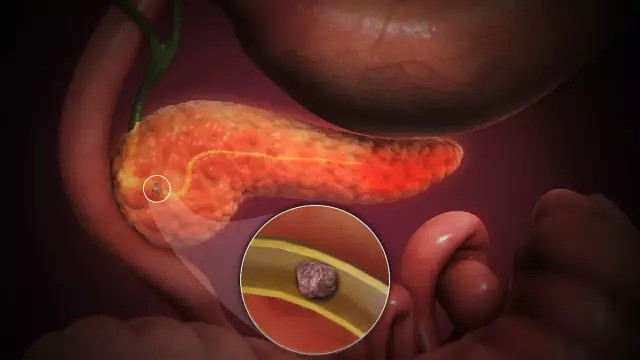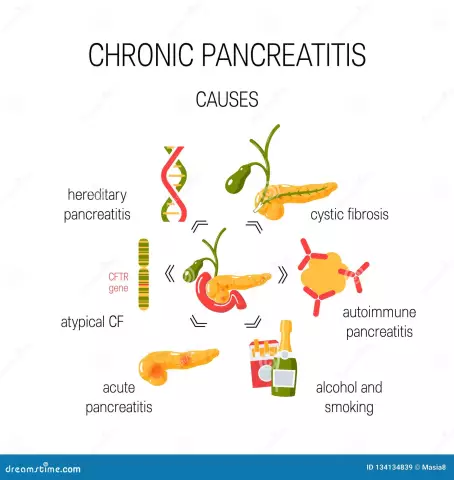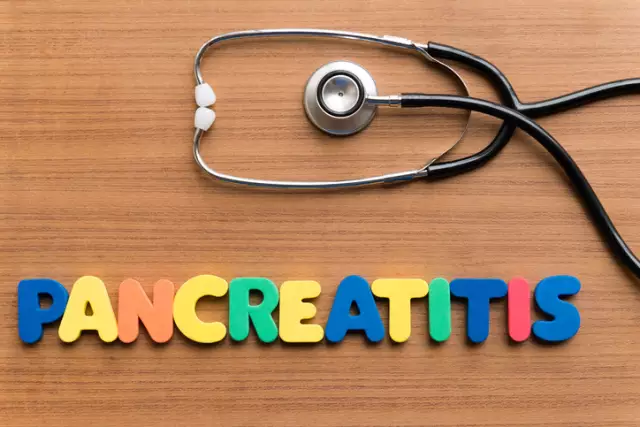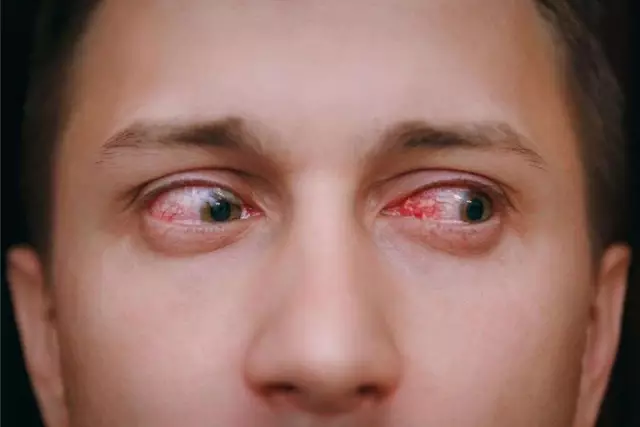- Author Rachel Wainwright [email protected].
- Public 2023-12-15 07:39.
- Last modified 2025-11-02 20:14.
Pancreatitis
Brief description of the disease

Pancreatitis is a disease characterized by inflammation of the pancreas. Normally, the pancreas has two important functions. Firstly, the pancreas produces enzymes that, when they enter the small intestine, are activated and participate in the digestion of proteins, fats and carbohydrates. Secondly, this organ produces the hormone insulin, which regulates blood glucose levels.
If, due to various reasons, the enzymes of the pancreas begin to be activated even inside the organ, the gland itself is digested and an inflammatory process develops.
There are two forms of pancreatitis: acute and chronic pancreatitis.
Acute pancreatitis
Most often occurs in obese women aged 30 to 60 years. The onset of the disease is characterized by acute girdle pain in the upper abdomen, most often after drinking alcohol or fatty foods. The pain can be mild, bearable, or very severe, radiating to the scapula or sternum. The pain can be so intense that in some cases, the patient may develop shock or collapse. There is nausea, vomiting, stool disturbance. Due to the obstructed outflow of bile, the skin and sclera take on a yellowish color. Sometimes cyanosis of the skin of the abdomen and the anterior abdominal wall is possible. Symptoms of intoxication are observed, the tongue in acute pancreatitis is dry and coated with bloom.
At the onset of the disease, bloating is observed, while the abdominal wall remains soft. With the development and progression of acute pancreatitis, muscle tension and symptoms of peritoneal irritation are observed.
Acute pancreatitis can result in recovery or become chronic. Particularly severe cases of acute pancreatitis can be fatal.
Chronic pancreatitis

There are several forms of the disease: recurrent pancreatitis, latent, pseudo-humorous and sclerosing pancreatitis. Pain sensations in chronic pancreatitis of varying intensity, paroxysmal or constant. The main localization of pain is in the upper part of the abdominal wall with radiation to the back, chest (left side), lower abdomen. Fatty heavy foods, alcohol intake, stress and other factors can provoke the onset of pain. The development of chronic pancreatitis is characterized by nausea, loss of appetite, bloating, abnormal stool, and sometimes vomiting. Jaundice is possible due to a violation of the outflow of bile.
Chronic pancreatitis is characterized by periods of remission and exacerbation. With the course of the disease, periods of exacerbation become more frequent, the development of intestinal disorders, disturbances in normal digestion, and weight loss are possible. Development of diabetes mellitus is possible.
Chronic pancreatitis often gives complications, including gastric bleeding, cancer, cysts and abscesses, liver damage, diabetes mellitus, enterocolitis.
Pancreatitis reasons
The main causes of pancreatitis are gallbladder disease, drinking alcoholic beverages, abdominal trauma, taking certain medications, various infections, hormonal disorders, vascular diseases, parasitic invasions, surgery on the gastrointestinal tract. In a third of patients, it is not possible to establish the true cause of the disease.
Pancreatitis symptoms
The main symptom of pancreatitis is pain in the upper abdomen. The pain is girdle, can be paroxysmal or constant. The use of analgesics and antispasmodics does not always relieve the condition. Vomiting, diarrhea or constipation, nausea, dizziness, and weakness are also observed. Bloating, belching may bother you. The patient loses weight, appetite disappears.
The symptoms of pancreatitis are pronounced. The disease is difficult and makes patients seek medical help.
Pancreatitis treatment

Treatment of acute pancreatitis requires a hospital stay. In case of pain, cold is shown to the pancreas area, therapeutic fasting, alkaline drinking, possibly suction of stomach contents through a probe. The diet for pancreatitis is a protein-carbohydrate diet, it involves the restriction of table salt, the exclusion of milk. As the symptoms of pancreatitis subside, the diet expands.
Drug treatment for pancreatitis involves the appointment of analgesics and antispasmodics (analgin, baralgin), drugs that inhibit the secretory function of the pancreas and stomach (cimetidine, atropine), as well as drugs that inactivate proteolytic enzymes (pantripine, counterkal).
If conservative treatment of pancreatitis does not give tangible results, surgical intervention is indicated.
Diet for pancreatitis
Diet for pancreatitis is used in the case of a chronic course of the disease and during the recovery period.
The diet involves a decrease in energy value, strict restriction of fats and carbohydrates. You should not take foods that promote gas formation in the intestines, contain coarse fiber, stimulate the production of gastric juice.
Diet for pancreatitis involves steaming, boiling and baking. Do not eat too hot or cold food.
With pancreatitis, it is allowed to use lemon tea, fruit and berry juices diluted with water, without sugar, dried wheat bread, unsweetened cookies. You can eat fermented milk products and low-fat cottage cheese.
The soup must be cooked without adding meat with different vegetables: carrots, potatoes, zucchini, cereals and pasta. You can add a little butter or low-fat sour cream to the soup.
Meat - lean, preferably beef, veal, chicken, turkey, rabbit. Cook boiled or steamed, you can make chopped cutlets. Fish to eat low-fat varieties in boiled form.

The diet for pancreatitis involves eating semi-viscous cereals from various cereals (buckwheat, oatmeal, semolina, rice), as well as boiled pasta.
Use up to 30 grams of butter per day, vegetable oil - no more than 10-15 grams, adding to various dishes.
Patients can eat various vegetables: carrots, potatoes, pumpkin, beets, green peas, zucchini.
Of fruits, ripe and non-acidic are allowed.
Fresh fruit compotes should not contain a lot of sugar.
It is forbidden to eat various carbonated drinks, coffee, grape juice, cocoa.
The diet for pancreatitis involves the rejection of fresh bread and baked goods, soups with meat broth, cold soups (such as okroshka), borscht, milk soups.
Hard-boiled eggs and meals made with whole eggs are prohibited.
Fatty meat, smoked meats and sausages, offal are prohibited.
Do not eat legumes and friable cereals. It is worth limiting the consumption of millet, corn, pearl barley and barley.
Do not eat radishes, cabbage, radishes, garlic, sorrel, onions, bell peppers, grapes, dates, figs and bananas.
Patients need to give up confectionery, chocolate, ice cream, various spices, alcoholic beverages, lard and cooking fats.
YouTube video related to the article:
The information is generalized and provided for informational purposes only. At the first sign of illness, see your doctor. Self-medication is hazardous to health!






